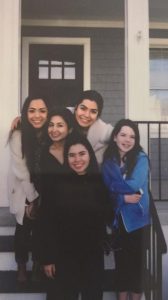I’m a SAHM and I have an au pair. People ask me, “Why?” My reply, “Why not?” When I resigned from teaching full time, I never expected that I would be in the house with my kids 24/7/365, waiting for my husband to get home so I could throw the household responsibilities on him as he walked in the door. More than ever, I needed a life outside of the home now that I would not be at work, interacting with people, using my lunch hour to run an errand or enjoying five minutes alone in my car. We decided to hire a part time nanny when my son was born, mainly to deal with the morning madness. Getting my 4 year old to PreK, with an infant was going to be hard (not impossible) and stress inducing. Being on a pick up and drop off schedule for school at the same time as an infant’s changing nap schedule was not something I was looking forward to either. We decided having someone 4-5 hours a day was all we needed. It gave me a break, helped keep the baby on his routine and allowed my daughter to make it to school on time, fed and prepared each day. I was happy to food shop alone, get to the gym and enjoy a break before the big one came home and we ran to and from the playground and after school activities, followed by dinner, baths and bedtime.
Fast forward 5 years and it’s kindergarten for my baby. (Fourth grade for my older child.) The part time nanny has been with us all these years and she’s ready to start her career after finishing up her schooling. It was then that I decided to consider hosting an au pair, not because I needed “child care” but I wanted an extra set of hands at home, more of a mother’s helper. A consistent, reliable mothers helper. Sure, MOST au pairs are considered for 45 hour a week child care for working parents. I needed about half of that, but I wanted one consistent person, who knew my children, my household rules and routines, that could be the other adult in the house for when I needed it. So after a 4-6 week process, we selected our first au pair. We went with Cultural Care Au Pair, mainly because they had about 50-60 au pairs in my zip code. 
Currently, we are on our third au pair in three years and I truly believe that it’s been a great experience for all. It wasn’t until the end of this past school year when I discovered my daughter’s memoir writing assignment that I realized how much this has meant to her. The assignment was to think about three memories that were meaningful to them and describe it. My daughter (age 12) wrote about meeting our first au pair and “Learning a New Culture.” I would love to post it, but couldn’t do that to her….as it was likely one of the most personal pieces of writing ever. She talked about how excited she was to meet her, the things they did together, how she is like a sister to her and how much she learned from her. In her year with our family, she treated my daughter like a little sister and gave her some wonderful advice on friendships and hard work. Much of this same advice was given to her by me (her mom) over the years, but if you know tween girls, they believe it when someone other than mom says it!

Here are some “truths” about hosting an au pair. From here on in I will use the abbreviations: AP, HM and HF- au pair, host mom and host family. The lingo is quite interesting and after three years, we have a good understanding of it.
- It’s not a luxury. It’s actually quite affordable. It’s assumed by many that live in help is so expensive. It can be– but with an AP you’re paying a weekly stipend of $200. Some APs work 20-25 hours a week, some work 45. Some have 1 child to care for, while others have 4. It’s the same stipend whether you live in NY, LA, Miami or North Dakota. The other money that is paid goes to the agency that transports the APs to the US, handles Visas with the Department of State, trains the APs, supports them while here, etc. It’s bundled into an administrative fee paid directly to the agency that you’re with. Depending on the agency it’s in the neighborhood of $8,000 per year. So plan on your 45 hour work week costing around $350-$375 per week more or less. If you consider day care will cost that for one child, it works out when you have a second or third child factored in.
- Your schedule is flexible, unlike any other child care situation. If your needs change from week to week, you’re able to switch up the schedule as needed. If you work odd or rotating hours, it works. You can schedule 3 long days, a weekend day, evening hours or a “split schedule” which is what parents with school aged kids set up. Morning 7-9am and Afternoons 3-7pm. When there are changes to the schedule (half days, school breaks, sick kids) you can adjust it, with notice.
- Sometimes the AP is your 3rd adult. Sometimes she’s your 3rd kid. I mean this in the nicest way. Our APs have all been trustworthy and responsible. But at the same time, they have been like an older sister to my two– who were 5 and 9 when we started the program– Now 8 and 12. Although they have all been in their early 20s, I have made sure to buy them Valentine’s gifts, like I do for the kids, winter boots for the snow, Halloween costumes and more. The APs are often leaving their family’s home for the first time and still need a mom. APs refer to moms as the HM, host mom.
- It’s good for the marriage. This should have been #1 and I think my husband would agree. There’s no “his and her” lists of things to do for the kids. If he wants to go to the gym after work, I am not telling him he can’t because of homework or showers. Having a second adult in the house to stay back and shower one kid while I’m out picking up the other from an activity is simpler all around. I could bring my son to sit outside the dance studio and do his homework while eating an afternoon snack– but having someone home to let him have a quiet house (or a playdate of his own) is a nice option to have too. It doesn’t hurt that we can go out to dinner alone every Thursday and that when I have nights out, I tell him that dinner is in the fridge and the kids are covered!
- They don’t clean! You would not believe how many people ask me this question, so I am including it. NO. They aren’t your cleaning person. They can straighten up the toys or wash the kids clothing but don’t expect a sparkling bathroom. The way a typical member of a family will load or unload the dishwasher, they can be expected to pitch in and help. The same goes with cooking. My au pair can grill hamburgers for the kids or make ravioli for them for dinner– but when we order in, I make sure to get her the dinner she wants too. So preparing meals for the kids and packing a lunch are OK, but don’t leave a gluten-free cookbook with sticky notes on the pages on the meals you want. On nights that I cook the full meal, she’s kicking a ball outside with my son and reminding my daughter to get into the shower or pack her school bag for the morning. Pets are also a no-no. People do it, but not the responsibility of the AP.
- Their lifelong dream isn’t to watch your kids. This job is a full experience. Many APs come to the US to learn English, take classes, meet new people from other countries and travel. This job enables them to achieve a lot of these things. Most are college educated, even professionals in their home country. Some use this year as a gap year before starting their studies. Overall, they have their own wish list while they are here and it’s important to be mindful of this. They are usually not formally trained to deal with little kids, so they have a lot to learn when they get here. Again, many are coming from their family home to yours, without living on their own, owning their own car, paying bills, etc. They intend to do this for a year (the maximum is two years) and pursue their other life goals. To take it a step further, I might even add that they aren’t here because they have to be. It’s a decision they make with their family and the family allows them to go and have this experience in the US. I have found (just in my own experience with APs and their friends) that they come from wonderful families, who value the learning experience and want them to have an opportunity like this- sort of how American families allow their kids to study abroad for a semester.
- Your kids will thank you for it. There’s a lot of benefits for children. Language is usually the most common interest for the HF. They want their child to learn from the AP but really the AP learns from the kids. My children have only a handful of Spanish words after 3 years of Spanish speaking APs. My kids have asked to see pictures of what it’s like back home, wanted to learn about their families, often FaceTiming with the parents. We have been unusual in that we’ve hosted some family members and friends over the years and met up on vacation with the families of the APs. I do not think that’s typical but it’s worked out for us and my children have enjoyed this time more than I ever imagined they would.









